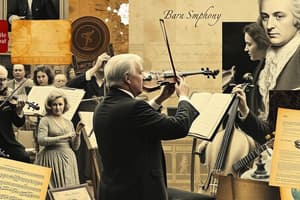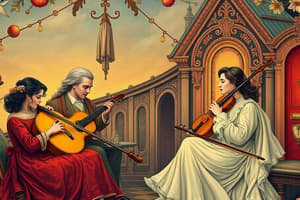Podcast
Questions and Answers
Who is the composer of Symphony No. 40 in G minor?
Who is the composer of Symphony No. 40 in G minor?
- Johann Sebastian Bach
- Wolfgang Amadeus Mozart (correct)
- Ludwig van Beethoven
- Pyotr Ilyich Tchaikovsky
What is the title of the work composed by Mozart that is being referred to?
What is the title of the work composed by Mozart that is being referred to?
Symphony No. 40 in G minor, First Movement
What period is Wolfgang Amadeus Mozart associated with?
What period is Wolfgang Amadeus Mozart associated with?
Classical Period
What genre does Symphony No. 40 belong to?
What genre does Symphony No. 40 belong to?
What form is used in Symphony No. 40?
What form is used in Symphony No. 40?
Which instruments are prominently featured in Symphony No. 40?
Which instruments are prominently featured in Symphony No. 40?
What is described about the melody and harmony in Symphony No. 40?
What is described about the melody and harmony in Symphony No. 40?
What is the rhythm and meter of Symphony No. 40?
What is the rhythm and meter of Symphony No. 40?
What type of texture is primarily found in Symphony No. 40?
What type of texture is primarily found in Symphony No. 40?
The first theme and second theme in Symphony No. 40 are contrasting in nature mainly due to their ________ composition.
The first theme and second theme in Symphony No. 40 are contrasting in nature mainly due to their ________ composition.
Flashcards are hidden until you start studying
Study Notes
Composer
- Wolfgang Amadeus Mozart is the renowned composer of this symphony.
Work
- Symphony No. 40 in G minor, First Movement is a significant orchestral piece.
Period
- Composed during the Classical Period, characterized by clarity and balance.
Genre
- The work falls under the genre of Symphony, a large-scale orchestral composition.
Form
- Structured in Sonata Form, which includes Exposition, Development, Recapitulation, and a Coda.
Instruments/Voices
- Orchestration includes Woodwinds, Horns, and Strings, creating a rich sound palette.
Melody/Harmony
- The tonic key is minor, with a contrasting second theme in major. Melodies are notably tuneful, enhancing emotional depth.
Rhythm/Meter
- Composed in Duple Meter, providing a steady and accessible rhythmic feel.
Texture
- Predominantly homophonic, combining melody with accompaniment, but incorporates polyphony at key moments, like the end of the second theme group, development, and coda.
Other Features
- The first and second themes contrast sharply:
- The rhythmic composition varies: the first theme features quicker, shorter rhythmic values, while the second theme has longer values.
- Articulation differs between themes, enhancing their contrasting nature.
- As per sonata form conventions, the second theme is revisited in the tonic key (minor) during the recapitulation.
Studying That Suits You
Use AI to generate personalized quizzes and flashcards to suit your learning preferences.




